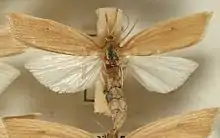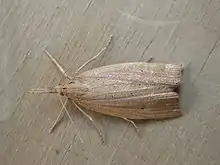| Chilo phragmitella | |
|---|---|
 | |
 | |
| Scientific classification | |
| Domain: | Eukaryota |
| Kingdom: | Animalia |
| Phylum: | Arthropoda |
| Class: | Insecta |
| Order: | Lepidoptera |
| Family: | Crambidae |
| Genus: | Chilo |
| Species: | C. phragmitella |
| Binomial name | |
| Chilo phragmitella (Hübner, 1805) | |
| Synonyms | |
| |
Chilo phragmitella is a species of moth of the family Crambidae, sometimes referred to by the vernacular names wainscot veneer[1] or reed veneer.[2] It was first described by Jacob Hübner between 1805 and 1810 as Tinea phragmitella, and is the type species of the genus Chilo.[3]
Chilo phragmitella occurs in wetland habitats with reed beds and paddy fields, and can be found in much of Europe, including Great-Britain, and parts of Asia.
Original description
Date of original description
The species was, as Tinea phragmitella,[4] first described by Jacob Hübner in his work Sammlung europäischer Schmetterlinge,[3] a multi-volume work with publication dates from 1793 to 1841.[5] Francis Hemming, in his 1937 systematic treatment[lower-alpha 1] of the entomological works of Jacob Hübner, narrowed the range of years in which the description of Tinea phragmitella may have been published to 1805–1810.[5]
Etymology
The specific name phragmitella refers to the species' larval food source.[6]
Distribution and habitat
Chilo phragmitella occurs in most of Europe,[4] including the British Isles.[7] It is also known from parts of Asia, including Iran,[8][9] Iraq,[9] Japan[9] and China.[9] It is found in wetlands with large reed beds[10] and paddy fields.[8]
Behaviour and appearance

Immature stages
Larvae are whitish and feed internally from stem and rootstock of common reed (Phragmites australis) and reed sweet-grass (Glyceria maxima).[7][11] Larvae take two years to mature.[12][13] Prior to pupation, the larva creates a hole in the stem to exit from as moth. Pupation occurs within the stem beneath the exit created by the larva.[7][14]
Adult
Adults are sexually dimorphic, with smaller, darker males. Wingspan is respectively 24–32 mm for males and 30–40 mm for females.[7] Both sexes have long labial palpi.[11] Female specimens of Chilo phragmitella may resemble those of Donacaula forficella.[6]
Depending on location, adults may be on wing from May to September. In Great-Britain, adults are on wing from June to July in a single generation.[7]
Handbook of British Lepidoptera
The following description of Chilo phragmitella was published in Edward Meyrick's 1895 A Handbook of British Lepidoptera:[15]
The face with a conical horny projection. The labial palpi longer than head and thorax. Forewings in female much narrower and more acute than in male ; pale ochreous, more or less suffused with brown, especially in male, tending to form dark streaks on and between veins ; a dark fuscous discal dot ; termen sinuate. Hindwings are pale whitish-ochreous or whitish, The larva is ochreous -whitish ; dorsal, subdorsal, and lateral lines reddish -brown ; head and plate of 2 yellowish -brown.
Notes and references
Notes
- ↑ Francis, Hemming (1937). Hübner: a bibliographical and systematic account of the entomological works of Jacob Hübner and of the supplements thereto by Carl Geyer, Gottfried Franz von Frölich and Gottlieb August Wilhelm Herrich-Schäffer. Royal Entomological Society of London.
References
- ↑ "Wainscot Veneer (Chilo phragmitella)". iNaturalist. Retrieved 25 August 2022.
- ↑ Wheeler, Jim (2017). Micro moth vernacular names: a nomenclatural checklist of British microlepidoptera. ISBN 9780956835239.
- 1 2 Bassi, G. (2021). "Notes from Old World Crambinae (II). New species of Chilo Zincken, 1817 (Lepidoptera: Pyraloidea)". SHILAP Revista de lepidopterología. 49 (196): 747–752. doi:10.57065/shilap.248. S2CID 254850424.
- 1 2 "Chilo phragmitella (Hübner, 1805) | Fauna Europaea". Fauna Europaea. Museum für Naturkunde Berlin. Retrieved 22 August 2022.
- 1 2 Watson, L.; Dallwitz, M.J. (14 April 2022). "Insects of Britain and Ireland - Hübner's collection: updated legends". www.delta-intkey.com. Retrieved 25 August 2022.
- 1 2 Muus, T.S.T.; Corver, S.C. (2022). "Chilo phragmitella (Hubner, 1810)". Microlepidoptera.nl, atlas van de kleine vlinders in Nederland (in Dutch). Retrieved 24 August 2022.
- 1 2 3 4 5 Goater, Barry (1986). British Pyralid Moths. Harley Books. pp. 22–23. ISBN 0946589089.
- 1 2 Jalaeian, M.; Golizadeh, A.; Sarafrazi, A. (August 2017). "The geographical distribution of moth stem borers (Lep.: Crambidae & Noctuidae) in paddy fields of Iran". Plant Pest Research. University of Guilan. 7 (2). Abstract. doi:10.22124/iprj.2017.2436.
- 1 2 3 4 Roohigohar, Sh; Alipanah, H.; Imani, S. (2016). "Crambinae of Iran (Lepidoptera: Pyraloidea, Crambidae)". SHILAP Revista de lepidopterología. 44 (175): 492. Retrieved 25 August 2022.
- ↑ "Chilo phragmitella | NatureSpot". Retrieved 25 August 2022.
- 1 2 Kimber, Ian. "Chilo phragmitella | UKmoths". www.ukmoths.org.uk. Retrieved 22 August 2022.
- ↑ Schütze, K.T. (1931). Die Biologie der Kleinschmetterlinge unter besonderer Berücksichtigung ihrer Nährpflanzen und Erscheinungszeiten (Scan/transcription) (in German). p. 21. Retrieved 22 August 2022.
- ↑ Ellis, Willem N. "Chilo phragmitella – Plant Parasites of Europe". bladmineerders.nl. Retrieved 25 August 2022.
- ↑ Watson, L.; Dallwitz, M.J. (14 April 2022). "Insects of Britain and Ireland: the genera of grass moths (Pyralidae-Crambinae and Schoenobiinae)". www.delta-intkey.com. Retrieved 25 August 2022.
- ↑ Meyrick, E., 1895 A Handbook of British Lepidoptera MacMillan, London pdf
 This article incorporates text from this source, which is in the public domain. Keys and description
This article incorporates text from this source, which is in the public domain. Keys and description
External links
- waarneming.nl (in Dutch)
- Lepidoptera of Belgium Archived 2012-04-01 at the Wayback Machine